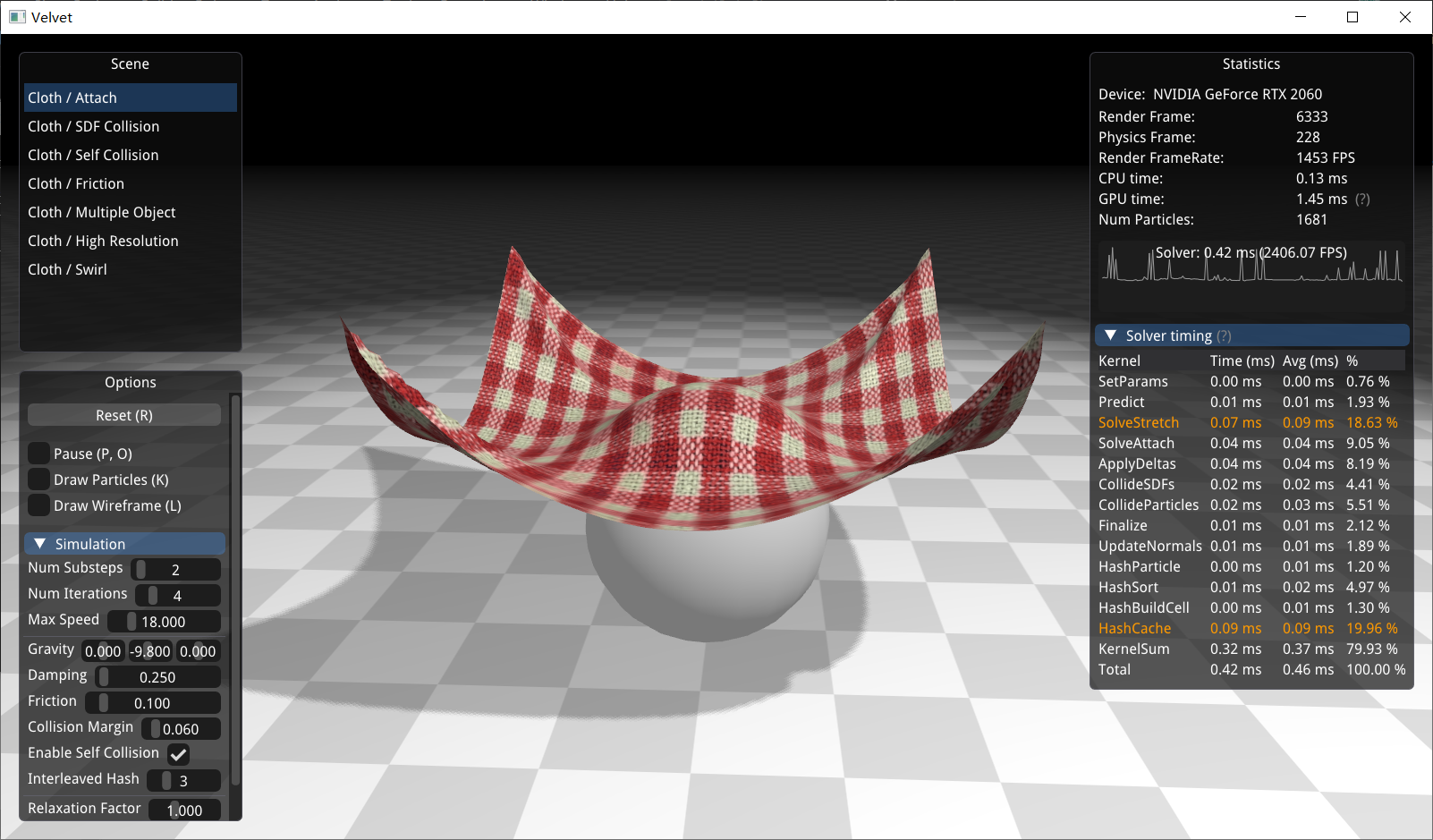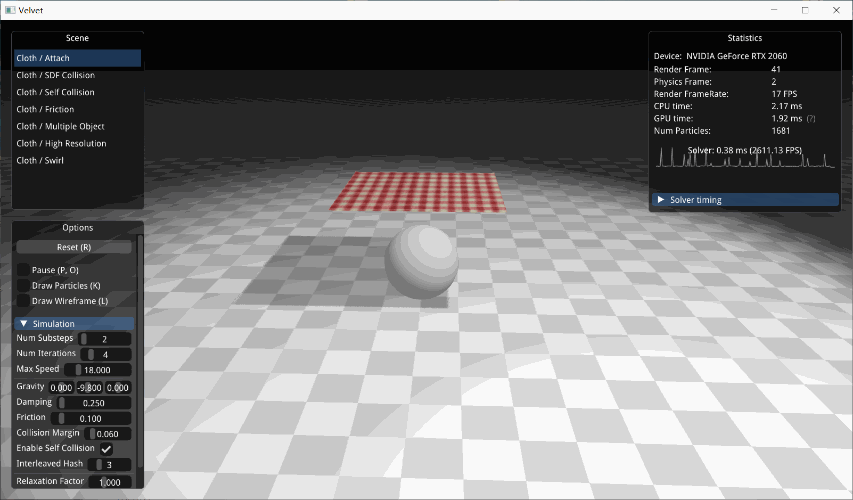The project provide a vckpg.json + CMake build toolchain to define the dependencies and build the project. To isolate the project, we use vcpkg manifests mode.
Make sure you have vcpkg installed.
If you have your vcpkg-configuration.json file, copy it at project root path.
Usually it has added the baseline, however, if it is not working, you can delete the baseline on vcpkg.json and run the following command:
vcpkg x-update-baseline --add-initial-baseline
see https://stackoverflow.com/questions/75184879/builtin-baseline-in-vcpkg-for-installing-franka-matlab
To further interoperate with CMake, you can using CLT with VCPKG toolchain definition:
cmake -DVCPKG_CHAINLOAD_TOOLCHAIN_FILE=<...> ..
or export the toolchain file by setting the environment variable CMAKE_TOOLCHAIN_FILE to (VCPKG_PARENT_FOLDER)/vcpkg/scripts/buildsystems/vcpkg.cmake
At runtime, copy folder Velvet/Assets to the same parent path as the executable, as inside the source code, it use relative path to load the assets.
Velvet is a CUDA-accelerated cloth simulation engine based on Extended Position Based Dynamics (XPBD).
There are already lots of cloth simulation project around. But most of them are executed on the CPU, thus suffers from low performance.
Flex is a great GPU-accelerated physics engine which is developed by the authors of Position Based Dynamics, but the project close-sourced their physics simulation code.
It's a non-trivial task to implement cloth simulation on GPU. There are many more issues that need to solved and their solutions aren't easy to find.
This project intend to reproduce the behavior of Flex and open-source our solutions. We hope that this project can make it less painful for other developers to learn GPU cloth simulation.
- Constraints
- Attach constraints
- Long range attachment constraints
- Stretch constraints
- Bending constriants
- Collisions
- SDF collision
- Particle collision
- Spatial hash neighbor finding
- OpenGL rendering
Velvet is built using Visual Studio 2019, C++ 17 and CUDA 11.1. Extra dependencies includes:
- glfw3: For window managing
- glad: For OpenGL
- fmt: For better printing functionality
- glm: For 3D mathematics
- assimp: For model loading
- imgui[core, opengl3-binding, glfw-binding]: For graphical user interface
Executable is provided and can be launched using run_velvet.bat.
If you want to build from source by yourself, dependencies can be installed using vcpkg:
./vcpkg.exe install glfw3:x64-windows
./vcpkg.exe install glad:x64-windows
./vcpkg.exe install fmt:x64-windows
./vcpkg.exe install glm:x64-windows
./vcpkg.exe install assimp:x64-windows
./vcpkg.exe install imgui[core, opengl3-binding, glfw-binding]:x64-windowsIn computer graphics, building your own wheel can often be unevitable. But what fears most is that sometimes you don't even have recipe for the wheel you want to build. There are lots of great paper describing their methods, but many of the implementation details are left out or scattered across the internet.
The following provides some implementation details on GPU cloth simulation that may help you in someway. Most of the related code can be found in VtClothSolverGPU.[hpp, cuh, cu].
The methods and tricks of PBD is scattered across many papers and resources. Here is the summed up pipeline:
CollideSDF(); // Collide particles with Signed Distance Fields (Q1)
for (int substep = 0; substep < numSubsteps; substep++) // Reference: [Small steps in physics simulation, 2019]
{
PredictPositions(); // Predict particle positions
FindNeighborsBySpatialHash(); // Use spatial hashing to find particle neighbors
// Handle Collisions
CollideParticles(); // Collide particles with neighboring particles
CollideSDF(); // Collide particles with Signed Distance Fields
// Solve constraints
for (int iteration = 0; iteration < numIterations; iteration++)
{
SolveStretch(); // Stretch constraint keeps the distance between two particles
SolveAttachment(); // Attachment constraint keeps the distance between a particle and a 3D position
// SolveBending(); // Bending constraints doesn't work well on GPU (Q2)
ApplyDeltas(); // Apply position deltas accumulated in previous constraint solving (Q3)
}
Finalize(); // Update velocities and positions
}
ComputeNormals(); // Compute vertex normals for rendering- Q1: Why
CollideSDFis executed first?- Kinematic objects (objects controlled by animation, user input, etc.) can move really fast, and if particles collide with them inside PBD loop, particles will end up with really large velocities and produce unstable behavior (mostly large vibration). Therefore, we include a pre-stabilization pass (which use
CollideSDFin our project). This pass update the particle position$x_i$ directly, therefore will not influence particle velocity. - Reference: [Unified particle physics for real-time applications, 2014, Section 4.4 Initial Conditions]
- Kinematic objects (objects controlled by animation, user input, etc.) can move really fast, and if particles collide with them inside PBD loop, particles will end up with really large velocities and produce unstable behavior (mostly large vibration). Therefore, we include a pre-stabilization pass (which use
- Q2: Why not
SolveBending?- In my experience, bending constraints don't work well with Jacobi iteration. Using a small bending compliance is really difficult to converge, and results in particle clustering or vibration. Using large bending compliance makes little influence on overall visual results. Also, bending constraints are more expensive than other constraints. For your information, Flex also exclude bending constraints.
- Q3: What is
ApplyDeltas?- In GPU implementation, we normally replace the Gauss-Seidel iteration used in CPU version with Jacobi iteration for better parallization. The downside of Jacobi iteraiton is its slow convergence. If we directly update the predicted positions, the particles will vibrate. To address this issue, we accumulated the position changes of all constraints into another variable
deltas, and apply the averaged value to predicted positions in the end. - Reference: [Unified particle physics for real-time applications, 2014, Section 4.3 Successive Over-Relaxation]
- In GPU implementation, we normally replace the Gauss-Seidel iteration used in CPU version with Jacobi iteration for better parallization. The downside of Jacobi iteraiton is its slow convergence. If we directly update the predicted positions, the particles will vibrate. To address this issue, we accumulated the position changes of all constraints into another variable
In Position Based Dynamics, particle collision is an easy way to implement cloth self collision. However, the particle size can be difficult to choose. A small particle size leads to gaps inside cloth geometry, which results in particle tunneling and bumpy surface. A large particle size makes the cloth really thick and neighboring particles may constantly collide, which may results in erroneous buckling or folding.
In this project, we use a relatively large particle size (1.5x spring rest length), and employ collision filtering technique to ignore collisions between particles that are initially close.
A naive way to achieve collision filtering is to store all the pair of particles that are connected by springs (stretch constraints). But this data structure can be quite inefficient to query on GPU.
Our method is to store the initial particles positions in a memory buffer initialPositions. During particle neighbor finding phase, we can easily determine whether particles are initially close by examine their initial distances using initialPositions.
Note that in industrial usage, simulators rarely use particles for collision. It's difficult to control the cloth thickness and the surface can be quite bumpy. But for simplicity's sake, particle collision is a great choice.
A common problem you will notice after porting a CPU cloth solver to GPU is that cloth becomes really stretchy. This is caused by the slower convergence rate from using Jacobi iteration.
Of course you can just increase the number of substeps and iterations, but this way the performance will degrade really fast.
A relatively cheap way to address this problem is to use Long Range Attachments (Reference: Long range attachments - A method to simulate inextensible clothing in computer games, 2012).
The LRA is quite simple. In the original PBD, when solving an attachment constraint, you modify the attached particle's position only. With Long Range Attachment, all particles are required to stay within a distance from the attached point. This mechanism can be easily implemented by adding another attribute attachDistances into attachement constraints.
4.1 Atomic updates
Many kernels in GPU cloth simulation use atomic updates to avoid conflict between different threads. Below is a useful method to improve the atomic performance by including a reorder parameter.
The atomic updates for the x,y,z components of a vector is reordered based on the reorder value. This decreases the chances by 2/3 that multiple threads are updating the same memory location at the same time.
The value of reorder can be choosed easily, for example stretch constraints can use the sum of two particle's ID.
__device__ inline void AtomicAdd(glm::vec3* address, int index, glm::vec3 val, int reorder)
{
int r1 = reorder % 3;
int r2 = (reorder + 1) % 3;
int r3 = (reorder + 2) % 3;
atomicAdd(&(address[index].x) + r1, val[r1]);
atomicAdd(&(address[index].x) + r2, val[r2]);
atomicAdd(&(address[index].x) + r3, val[r3]);
}4.2 Spatial hashing
We follow the CUDA sample project particles for spatial hashing implementation. There are some easy optimizations that can be made to improve its performance:
-
Sort Algorithm
The particles project use
thrust::sort_by_keyfor sorting. In my experience, thrust's performance aren't that great. By replacing this withcub::DeviceRadiusSort::SortPairs, the sorting performance can be improved by roughly 50%. -
Neighbor Caching
Spatial hashing are expensive to compute, but we don't need to update the spatial hashing every time we do particle collisions. The neighbor information can be stored in an
neighborsarray and used for multiple times. In this project, we use a integer parameterinterleavedHashto control how many times neighbors are reused before recompute.The
neighborsarray are structured such thatneighbors[i + numMaxNeighborsPerParticle * j]stores thej-thneighbor for particlei. It's not recommended to organizeneighborsasneighbors[i * numMaxNeighborsPerParticle + j]since this disallows coalesced memory access.
4.3 Particle Rendering
Render particles make it easier to debug. However, even with instanced rendering, it can be get quite slow to render more than 100k particles (On my laptop with RTX2060, 50k particles can't make it to 60FPS).
A more efficient way is screen space rendering [Reference: Screen Space Fluid Rendering for Games]. Particles are rendered in screen space as billboard quads using geometry shader. Then the normals and depth of the pixels are mannually updated to produce the illusion of spheres. This is not physically accurate but much more efficient.

